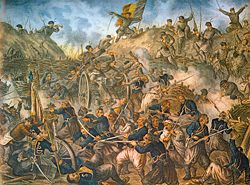Abdul Hamid II
Abdul Hamid II (21 September 1842 – 10 February 1918) was the 34th Sultan of the Ottoman Empire.[1] He was the last sultan to have complete control over the Empire. He was responsible of the Hamidian massacres. Killing between 100.000 - 300.000 Armenians. He witnessed many revolutions and wars. Abdul Hamid II ruled from 1876, until he was overthrown by a group of people calling themselves the "Young Turks" in 1909.[2] Abdul Hamid II was the last ruler who nearly had total authority. Meaning that his authority was hardly limited by policies or reforms such as a constitution.[2]
| Abdul Hamid II | |||||
|---|---|---|---|---|---|
| Caliph of Islam Amir al-Mu'minin Sultan of the Ottoman Empire Custodian of the Two Holy Mosques | |||||
 Abdul Hamid II in the late 19th century as a Sultan. | |||||
| Sultan of the Ottoman Empire | |||||
| 31 August 1876 – 27 April 1909 | |||||
| 7 September 1876 | |||||
| Predecessor | Murad V | ||||
| Successor | Mehmed V | ||||
| Born | 21 September 1842 Topkapı Palace, Constantinople, Ottoman Empire | ||||
| Died | 10 February 1918 (aged 75) Beylerbeyi Palace, Constantinople, Ottoman Empire | ||||
| Burial | Sultan Mahmud II Tomb | ||||
| |||||
| Royal house | House of Osman | ||||
| Father | Abdulmejid I | ||||
| Mother | • Tirimüjgan Sultan • Rahime Perestu Sultan | ||||
| Religion | Sunni Islam | ||||
| Tughra |  | ||||
Rule
He modernized the Ottoman Empire during his reign. Railways, schools and hospitals were built under his rule. He also seeked to unify the Muslims in the Empire under Pan-Islamism. Others had tried to unify people in the Empire under Ottomanism (identity based on shared belonging to the Ottoman Empire).
Sultan Abdul Hamid II was the one who authorized the building of the Hamidiye Mosque, which was finished in 1886.[3] The Mosque was built near the Yildiz Palace, and its decoration style combines the classical Ottoman with Neo-Gothic. It became a symbol for the ruler's authority.[2]
His reign ended as Young Turks revolted against him. In 1909, being persona non grata, he was forced to abdicate in favor of his brother, who became Sultan Muhammad V. Abdul Hamid II spent his last years under house arrest at the Beylerbeyi Palace in Istanbul, where he died in 1918.
Abdul Hamid II Media
Ottoman troops under Romanian attack at the Siege of Plevna (1877) in the Russo-Turkish War (1877–78)
Şehzade (Prince) Abdul Hamid in 1868.
20 kuruş during the reign of Abdul Hamid II, dating 1877
Opening of the first Ottoman Parliament (Meclis-i Umumî), at the Dolmabahçe Palace in 1877
References
- ↑ "Abdulhamid II". The Sultans. theottomans.org. Retrieved 22 February 2016.
- ↑ 2.0 2.1 2.2 Clancy-Smith; Smith, Julia; Charles (2014). The Modern Middle East and North Africa: A history in documents. New York: Oxford University Press. p. 82. ISBN 9-7-8-0-1-9-5-3-3-8-2-7-0.
{{cite book}}: CS1 maint: multiple names: authors list (link) - ↑ Clancy-Smith, Julia A. (31 December 2019), "The Middle East and North Africa in World History", The New World History, University of California Press, pp. 173–182, doi:10.1525/9780520964297-019, ISBN 978-0-520-96429-7, retrieved 29 February 2024






